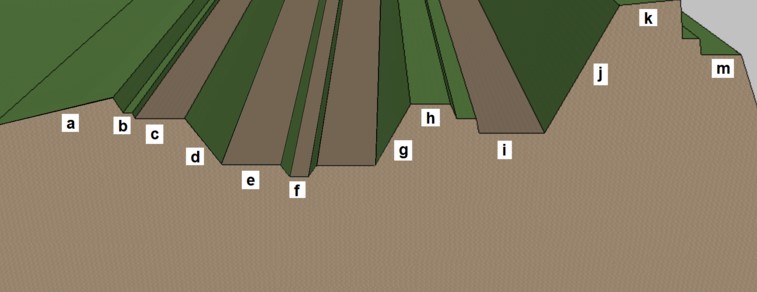Scarp
|
A section through the ditch and rampart of a typical early modern artillery fortification (16th to 19th centuries). The elements are: a) glacis, b) banquette, c) covered way or covertway d) counterscarp, e) ditch, f) cunette, g) scarp, h) faussebraye, i) chemin de ronde, j) rampart (exterior slope), k) parapet, m) terreplein. |
Contents |
[edit] Introduction
As a form of medieval military fortification, a scarp (also referred to as escarp or escarpment) was a term used to describe the inner slope of a defensive ditch. The outer portion of the slope or ditch was referred to as the counterscarp. Scarp and counterscarp defensive fortifications were built below grade - but visible to attackers - and adjacent to a moat or ditch.
NB With respect to modern topographic wind effects, the term escarpment, is defined by the ICC’s 2018 International Residential Code, as ‘a cliff or steep slope generally separating two levels or gently sloping areas.’
[edit] History
Scarp and counterscarp structures were introduced as a form of military defence in the 1500s. The technique was developed by Italians as a form of protection against enemies using cannons in their attacks.
As existing defensive walls were compromised, a technique using sloping ramparts was first used in Pisa in 1500. This method was tested to protect vulnerable areas from French attacks.
[edit] Improvements by Fra Giovanni Giocondo
The angled rampart proved more effective against cannon fire, and a few years later, the method was further advanced by Fra Giovanni Giocondo, a monk who had trained as an architect, draughtsman and engineer. Fra Giocondo was also involved in municipal engineering projects - such as road construction and bridge foundations (including the Pont Notre-Dame in Paris) - and was part of the team involved with the construction of the foundation piers of St. Peter's Basilica.
With extensive knowledge developed through his archaeological studies, Fra Giocondo was called upon by officials in several cities around Europe. During this period, he was asked to provide advice on military fortifications, which is when he proposed the idea of scarp and counterscarp fortifications. Fra Giocondo incorporated a sunken ditch into his sloping scarp-counterscarp design.
[edit] Additional modifications
Later advances provided additional protection to the scarp and counterscarp defense through the introduction of a stone faced glacis on the slopes. In some instances, the counterscarp may have been protected further with paling fencing to make it more difficult for attackers to invade.
Another sunken space behind the glacis was added to offer a hiding place for defenders. Counterscarp galleries were also introduced as a place for defenders to counterattack.
This type of fortress configuration was used for several centuries, until advances in weaponry required a new solutions.
[edit] Related articles
Featured articles and news
The UK's Modern Industrial Strategy: A 10 year plan
Previous consultation criticism, current key elements and general support with some persisting reservations.
Building Safety Regulator reforms
New roles, new staff and a new fast track service pave the way for a single construction regulator.
Architectural Technologist CPDs and Communications
CIAT CPD… and how you can do it!
Cooling centres and cool spaces
Managing extreme heat in cities by directing the public to places for heat stress relief and water sources.
Winter gardens: A brief history and warm variations
Extending the season with glass in different forms and terms.
Restoring Great Yarmouth's Winter Gardens
Transforming one of the least sustainable constructions imaginable.
Construction Skills Mission Board launch sector drive
Newly formed government and industry collaboration set strategy for recruiting an additional 100,000 construction workers a year.
New Architects Code comes into effect in September 2025
ARB Architects Code of Conduct and Practice available with ongoing consultation regarding guidance.
Welsh Skills Body (Medr) launches ambitious plan
The new skills body brings together funding and regulation of tertiary education and research for the devolved nation.
Paul Gandy FCIOB announced as next CIOB President
Former Tilbury Douglas CEO takes helm.
UK Infrastructure: A 10 Year Strategy. In brief with reactions
With the National Infrastructure and Service Transformation Authority (NISTA).
Ebenezer Howard: inventor of the garden city. Book review.
The Grenfell Tower fire, eight years on
A time to pause and reflect as Dubai tower block fire reported just before anniversary.
Airtightness Topic Guide BSRIA TG 27/2025
Explaining the basics of airtightness, what it is, why it's important, when it's required and how it's carried out.
Construction contract awards hit lowest point of 2025
Plummeting for second consecutive month, intensifying concerns for housing and infrastructure goals.
Understanding Mental Health in the Built Environment 2025
Examining the state of mental health in construction, shedding light on levels of stress, anxiety and depression.
The benefits of engaging with insulation manufacturers
When considering ground floor constructions.
Lighting Industry endorses Blueprint for Electrification
The Lighting Industry Association fully supports the ECA Blueprint as a timely, urgent call to action.
























